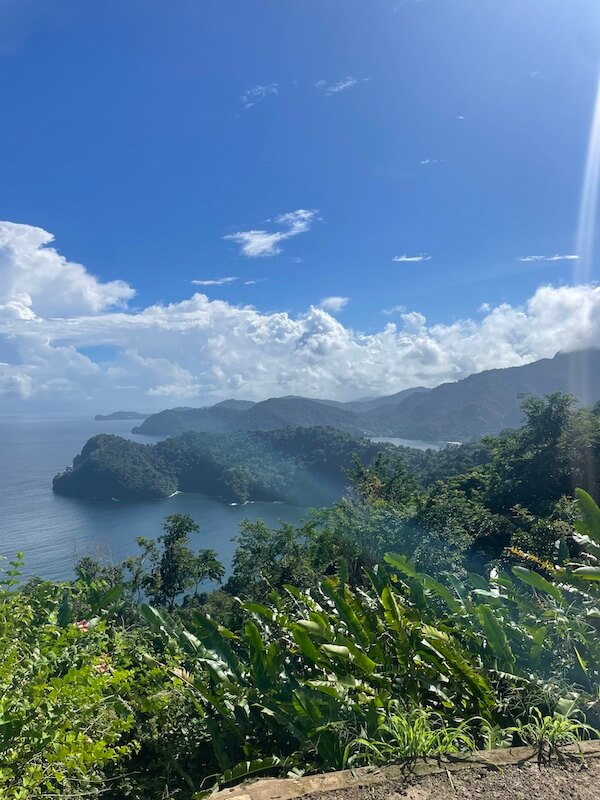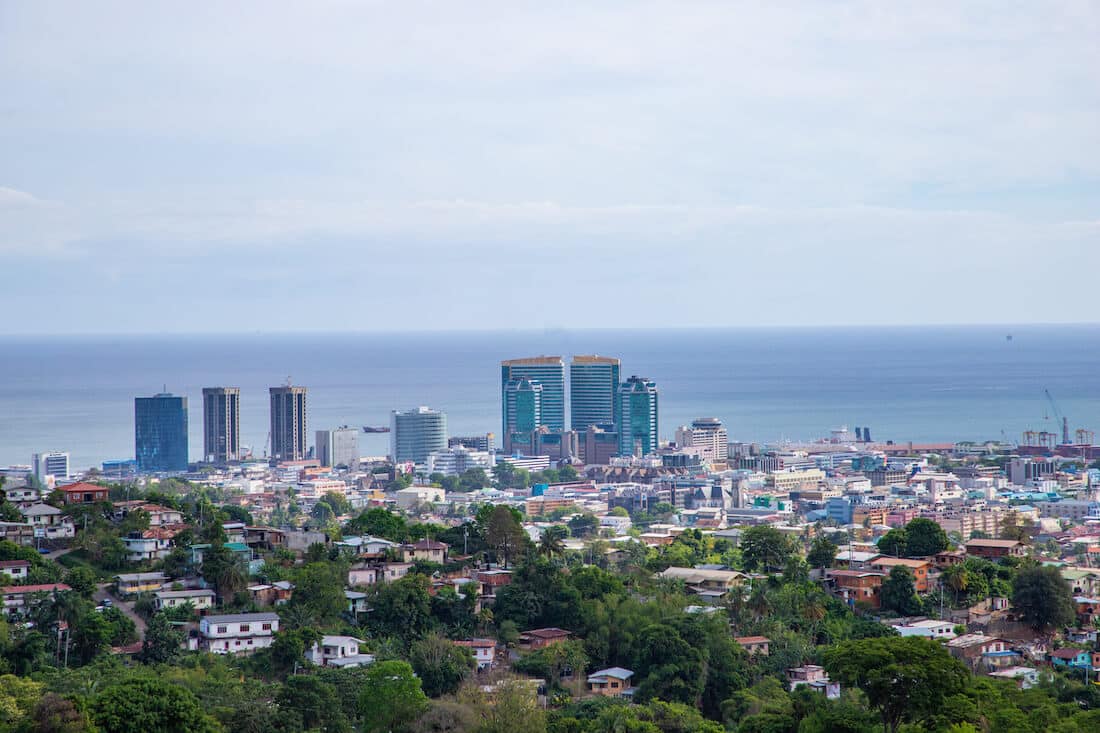Trinidad & Tobago
Trinidad & Tobago itineraryPristine beaches, lush green hills & good vibes
Duration: at least 3 weeks
Best time to travel: October-June
Budget: $85 per day
I’ve now spent months wandering these twin isles, and what keeps pulling me back isn’t just the sun and sand—it’s Trinidad’s electric heart( any my boyfriend).
Here, you don’t just visit culture—you live it. In Port-of-Spain, the streets pulse with steelpan rehearsals and vendors hawking doubles at dawn; you’ll find yourself joining liming crews under neon signs, swapping stories over a steamy roti or a bag of bake and shark. Every neighborhood feels like its own festival—East Indian pujas sit side-by-side with African drumming circles, and Chinese New Year fireworks flare above logwood-red sunsets.
Unlike resorts built for tourists, Trinidad moves to its own beat—fueled by oil dollars, yes, but grounded in generations of spice-blended kitchens, rainforests dripping with cacao pods, and the otherworldly silence of the Pitch Lake at dawn. Carnival season may be the planet’s biggest party, but even off-season there’s always a parang band strumming by the sea, a chutney jam in someone’s backyard, or a secret hike to bristle with hummingbirds and toucans.
Tobago’s quieter shores and ancient rainforest are pure balm after Trinidad’s electric buzz—each beach town has its own laid-back vibe, from speyside’s snorkel-ready reefs to Charlotteville’s fish fry Fridays. But if you really want to feel the soul of this country, you have to dance in Trinidad’s streets, feast at its roadside shacks, and let its endless energy carry you long after you’ve left.
- Culture 90%
- Beaches 85%
- Nature 110%
- Activities 100%
After loving Jamaica so much I was eager to explore Trinidad and Tobago. Both islands were equally captivating and I am sure to return soon.

Why visit Trinidad and Tobago?
Why visit Trinidad and Tobago?
Beaches in Trinidad & Tobago
Both islands are pretty hilly and green, giving the beaches and dramatic and picturesque backdrop. The waters shimmer from green to light turquoise in Tobago. I loved that in the absence of big hotels and mass tourism, we found a super pleasant mixture of locals and visitors by the beaches. While Tobago is without a doubt more of a beach vacation destination, I feel like Trinidad’s beaches are way underrated. I truly enjoyed the beaches in Trinidad and had lots of fun! Beaches like Maracas Bay and Las Cuevas are just 30–45 minutes from Port-of-Spain and have great food stalls, lifeguards, and easy parking.
Nature Adventures in Trinidad and Tobago
Trinidad and Tobago have some of the most breathtaking natural scenery in the Caribbean. From the lush rainforests on Trinidad to the wild, untamed beaches in Tobago, there are so many opportunities for you to explore the breathtaking beauty of these two islands. There are some hiking trails through the jungle-like forests with hidden waterfalls or treks across the undisturbed beaches.
Tobago is home to the oldest protected rainforest in the western hemisphere and is incredible to explore. This Caribbean gem is sure to take your breath away and leave you with some amazing memories. Bioluminescent waters in Tobago provide a really unique experience of the Caribbean Sea.
Culture in Trinidad and Tobago
With a diverse mix of influences from African, Indian, European and Native American cultures, this island nation truly offers a unique experience. And it even sometimes felt like traveling to completely different countries.
What I truly loved was that the locals are proud of their heritage and are more than willing to share it with visitors. One of the best ways to immerse yourself in the local culture is through the many festivals that take place throughout the year. Whether it’s the vibrant colours and sounds of carnival, the beautiful lights of Divali, or the poignant commemorations of Hosay, each event gives you a chance to connect with the locals and experience their traditions firsthand.
Carnival in Trinidad
When it comes to carnival celebrations, Trinidad knows how to throw one heck of a party. The energy and excitement in the air is palpable. There’s nothing quite like the sound of steel drums and the colorful costumes on display. But carnival in Trinidad isn’t just about the fun and festivities – it’s also a reflection of the country’s rich cultural heritage. From the traditional rhythms of Soca and Calypso music to the intricate details of the masquerade costumes, there’s a deep sense of pride in the customs and traditions that make up carnival in Trinidad. While the carnival in Trinidad is “the greatest show on earth”, Tobago’s carnival which was taking place for the first time in 2022 is a much smaller but not less exciting event taking place in October. Tobago was the first mas I ever played and I will never forget!
The music scene in Trinidad and Tobago
This dynamic duo is known for their infamous carnival, but there’s so much more to discover beyond the festivities. Home to Calypso, Soca, and steel pan, Trinidad and Tobago have a rich music history. These genres of music have played a significant role in shaping the islands’ culture and are deeply ingrained in their roots. When visiting Trinidad and Tobago, experiencing live music is one of the top things to do. Whether you’re at the Carnival, a music festival or just hanging out with the locals, you are guaranteed to have a good time with the island’s infectious music. Music flows through the veins of these islands, and it’s impossible not to be swept up in the rhythm of the steel pan. There are numerous talented musicians waiting to entertain you at local venues.
City vibes in Port of Spain
If you’re looking for a vibrant and diverse travel destination, Trinidad and Tobago’s Port of Spain should definitely be on your radar. This city has a fascinating mix of cultures, from Spanish to Middle Eastern to Chinese and everything in between, all of which are celebrated through food and events. It might not quite match up to Kingston in my book (what can I say, I’m biased!), but Port of Spain is still an amazing place to explore. There’s always something happening in this bustling city, which locals affectionately refer to as ‘Town.’ With the abundance of food, fun, and festivals, you’ll never run out of things to do in Trinidad and Tobago’s capital city.
Food culture in Trinidad & Tobago
The food scene really surprised me. I found that it reflected the diverse culture of Trinidad and Tobago, with a mix of flavors from African, Indian, Creole, and Chinese dishes. Street food is plentiful all over both islands. From roti to doubles to buss up shut to bake, there is definitely always a new dish to try.
Additionally, the islands are known for their seafood and fresh fruit. Tobago is especially well-known for its incredible seafood dishes like grilled lobster and crab. Trinidad’s cuisine is slightly spicier and features dishes such as pelau (a popular dish made with rice, pigeon peas, and chicken) and stewed oxtail.
Practical Travel Tips for Trinidad and Tobago
Language: English
Currency: TT Dollar
How to get to Tobago
You’ve got two main routes—by air or by sea—and both kick off your island adventure the moment you step on board.
By Air
Fly into ANR Robinson International Airport (TAB) just outside Scarborough. Caribbean Airlines and several regional carriers operate daily hops from Port of Spain (about 25 minutes), plus flights from hubs like Barbados, Antigua and select North American gateways.
When you land, licensed taxis (look for plates beginning with “H”) wait curbside at fixed rates—or pick up your rental car right at the terminal and set your own pace (we drive on the left).
By Ferry
Head to the Port of Spain ferry terminal for a comfortable sea crossing—most services depart twice a day and take roughly 2½–3 hours.
On clear days you’ll dramatic coastal views as you glide toward Scarborough’s harbor. Make sure to bring movement sickness pills as you might get sick though the ferry is very comfortable.
What is the best time to visit Tobago?
Your description goes here. Edit or remove this text inline or in the description settings
Is Tobago safe?
Is Trinidad safe?
Having spent months exploring Trinidad’s peaks, rainforests and city streets, I can tell you it’s generally safe—locals are warm and welcoming, and most visits pass without a hitch. That said, it pays to use common sense, especially in busy urban areas. Here’s what’s worked for me:
Stay aware in Port-of-Spain: Petty theft (pickpocketing, bag snatches) can happen in crowded markets or on public transport. Keep valuables in front-facing bags or money belts.
Use licensed taxis: Look for yellow plates starting with “H” and agree your fare before you hop in. Ride-hailing apps like TT Uber work well in the city.
Avoid empty, poorly lit streets at night: Stick to well-lit main roads or take a trusted taxi if you’re out late.
Secure your accommodation: Use hotel safes or locked luggage for passports, extra cash and electronics.
Watch your drink: As at any party hotspot (hello, Carnival!), keep an eye on your glass and never leave it unattended.
Beach & nature safety: Beaches like Maracas and Las Cuevas have lifeguards; ask locals about currents before swimming. On hikes, go with a group or guide and carry water, a phone and a headlamp if you’ll be back after dark.
How to get around Tobago?
Tobago’s compact size means you’ve got plenty of options—pick what fits your style and budget. I kicked things off by hiring a driver to show me the ropes, and after a day or two, I felt confident enough to get behind the wheel myself.
Rent a car
Freedom to roam: Ideal once you know the roads—go at your own pace to hidden bays, waterfalls and hillside lookouts.
Left-hand driving: Road signs are clear but some back roads get narrow and winding—take it slow, especially after rain.
Tip: I started with a local driver for a day’s island tour, then rented a car so I could explore solo.
Maxi Taxis (shared vans)
Budget-friendly: Fixed routes between Scarborough, Crown Point, Morningstar and Charlotteville.
Hail and hop: They leave when full—just flag one down at a stand or on the roadside.
Cost: Roughly TT $8–15 per ride, depending on distance.
Private Taxis
Door-to-door service: Look for yellow plates starting with “H,” agree on the fare upfront.
Great for groups: Negotiate half- or full-day rates to tour the island with friends.
Scooters & Bikes
Quick runs: Perfect for short hops between nearby beaches and villages—watch for potholes and always wear a helmet.
Where to rent: Crown Point and Castara have rental shops.
Water Taxis & Boat Charters
Sea routes: Some operators connect Store Bay, Pigeon Point and Blue Waters by boat—ask locally for schedules.
Private charters: Ideal for beach-hopping, snorkeling stops or a sunset cruise.
On Foot
Walkable towns: Castara, Speyside and Scarborough are great for strolling—pop into a rum shop or local bakery.
Trails & hikes: Many waterfalls and ridge walks start as footpaths—bring sturdy shoes.
What are the challenges for the conscious traveler?
Trash. Street food almost always comes wrapped in aluminum foil, and many restaurants serve it in to-go boxes. Luckily enough, a foldable food container will go a long way.
Generally speaking, responsible tourism practices are not (yet) prevalent in Trinidad or Tobago. Therefore, wear eco-friendly sunscreen when visiting waterfalls and the beach.
Sunscreen: Protect Marine life and wear reef-friendly sunscreen!
Sunscreen: Protect Trinidads coast by using reef-friendly sunscreen.
How to move between Trinidad and Tobago?
You’ve got two straightforward options—by air or by sea—and both are easy to book:
By Air
Duration: About a 25-minute flight.
Airlines: Caribbean Airlines runs multiple daily flights between Piarco International Airport (POS) near Port of Spain and ANR Robinson Airport (TAB) outside Scarborough.
Booking: Reserve online or through travel agents; flights often fill up around Carnival and Christmas, so book early if you travel in peak season.
On arrival: Taxis, rental cars and maxi-taxis are all waiting curbside at TAB to whisk you to your Tobago base.
By Ferry
Duration: Roughly 2½–3 hours on a comfortable passenger catamaran.
Departure/Arrival: Ferries depart Port of Spain’s ferry terminal and arrive at Scarborough’s bay.
Schedule: Typically two sailings each way daily; times vary by operator so check online or call ahead.
Booking & Fare: Buy tickets at the terminal or online; fares are budget-friendly and you can bring a small amount of luggage onboard.
Can I drink tap water in Tobago?
Generally, yes—the public water supply in Tobago is treated and routinely tested, so it meets local safety standards. In most hotels, guesthouses and restaurants you’ll find the tap water is chlorinated and perfectly fine for brushing your teeth or making coffee.
That said, if you have a sensitive stomach—or you’re heading off the beaten path to remote bays—I prefer to stick to a UV water bottle just to play it safe. Here’s my rule of thumb:
In Scarborough, Crown Point & major resorts: Tap water is usually OK; feel free to refill a reusable bottle at a filtered-water station.
In villages or rustic eco-lodges: Opt for bottled water, especially if you’re unsure about the plumbing.
During heavy rains: Occasionally there can be brief turbidity or boil advisories—your accommodation or tour operator will let you know.
What languages ars spoken in Trinidad and Tobago?
Standard English: The official language used in government, schools, media and business.
Trinidadian Creole & Tobagonian Creole: English-based creoles used in everyday conversation, with distinct local flavors on each island.
Spanish: Widely taught in schools and spoken, especially in communities near the Venezuelan coast.
Trinidadian Hindustani: A Bhojpuri-derived dialect preserved mainly by older Indo-Trinidadian families and in cultural events.
French Creole (Patois): A small, older community still uses this French-based creole in rural villages.
Tamil: Spoken by some elderly members of the Tamil-heritage community.
Chinese Dialects: Hakka and Cantonese are common among Chinese-Trinidadians, with some Mandarin among newer residents.
Sign Languages: The indigenous Trinidad and Tobago Sign Language serves the local deaf community, and American Sign Language is also used in schools and by many deaf individuals.
Packing List Caribbean
Are you getting ready to travel to Trinidad and Tobago? Check out my packing list to come prepared. You’ll find anything from cloths to useful travel gadgets and eco friendly travel products!
Places to visit in Trinidad & Tobago
Uncover the Hidden Treasures of Trinidad: Day Trips from Port of Spain
Duration: at least one week Budget: $ 150 per day Where to stay: Culture Crossroads Inn or Kapok HotelVisiting Port of Spain and looking for the perfect day trip? As someone who's spent a lot of time exploring this vibrant city and its surroundings, I can assure you...
Exploring the South of Trinidad: A Journey Through Hidden Gems
Exploring South Trinidad felt like uncovering a world of surprises—from the surreal La Brea Pitch Lake to quiet beaches and mouthwatering local flavors. In this guide, I share my personal experiences and travel tips to help you discover the magic too!
Driving in Trinidad: Why It’s Worth the Adventure
Driving in Trinidad gave me the freedom to explore breathtaking views, hidden spots, and remote beaches. In this guide, I share personal tips, favorite routes, and everything you need to know to confidently hit the road!
Things to do in Tobago
Ready to explore Tobago? Let me guide you through my favorite things to do on this stunning island – from hidden beaches and adventure spots to local gems that will make your trip unforgettable!
Sacred Spaces: A Guide to Trinidad’s Diverse Religious Sites
Trinidad’s religious sites are more than places of worship; they are windows into the island’s rich history, cultural diversity, and spiritual life. Whether you’re exploring Hindu temples, Christian cathedrals, or African Orisha shrines, each sacred space tells a story of resilience, faith, and community.
Beyond Carnival: Year-Round Festivals and Events in Trinidad (2024)
Did you know that Trinidad is home to over 20 major festivals throughout the year? While Carnival may be the island’s crown jewel, there’s so much more to discover beyond that iconic celebration.
Tobago Beach Guide
There’s something truly magical about Tobago’s beaches that goes beyond the white sand and turquoise waters.
Tobago Carnival 2025 | Planning Guide
Get ready for Tobago Carnival 2024! This guide covers everything you need to know, from booking flights and accommodations to choosing the perfect costume and navigating the road march. Plan early for an unforgettable carnival experience!
Things to do in Port of Spain | Trini’s notorious capital
Port of Spain is nestled along the beach and leading up to a hilly backdrop. Between the typical Caribbean houses, you’ll find some old colonial buildings. What became evident at first glance was the diversity of the population. A mix of African, Indian, Spanish, and other ethnicities can be seen throughout the streets.

















